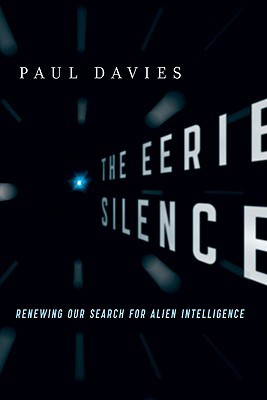

| THE EERIE SILENCE Renewing Our Search for Alien Intelligence Paul Davies Boston: Houghton Mifflin Harcourt, 2010 |
Rating: 5.0 High |
|||
| ISBN-13 978-0-547-13324-9 | ||||
| ISBN-10 0-547-13324-3 | 242pp. | HC/FCI | $27.00 | |
Released in 2010, this book marks the fiftieth anniversary of the Search for Extraterrestrial Intelligence, for it was in April 1960 that Frank Drake did the first cursory listening for ET signals with a large radio astronomy antenna in Green Bank, West Virginia. Davies, a SETI researcher himself, dedicates this book to Frank Drake. But this is more than just a paean to the SETI pioneer.
"I didn't just want to write a bland congratulatory book. Instead, I decided to take a penetrating look at the aims and assumptions of the entire enterprise. As I wrote it, I kept asking whether we might not be missing something important. Old habits of thought die hard, and a project that has been running for fifty years can benefit from a shake-up. In February 2008 I held a workshop at Arizona State University called "The Sound of Silence" to encourage radically new ways of addressing the evocative question "Are we alone?" The contents of this book reflect much of our discussion at the workshop..." – Page xiii |
The question of whether any alien artifacts are present in our solar system is impossible to answer at this point. Some fictional examples illustrate the scope of the problem. "The Sentinel," by Arthur C. Clarke, posited a dome in a crater on the Moon, filled with what were guessed to be monitoring devices. Stanley Kubrick's movie 2001: A Space Odyssey, inspired by the Clarke story, exchanged the dome for a black monolith in the crater Tycho. Neither device was found until humans actually walked around their locations. Buzz Aldrin and John Barnes wrote the novel Encounter with Tiber in which an ET signal is decoded to reveal the presence of an alien repository of knowledge on Mars. James Hogan's Giants series begins with the discovery in an archaeological dig of what can only be a prehistoric radio transceiver. These are but a few of hundreds of such stories. Also, of course, there have been serious claims of constructions on the Moon, on Mars, and in Saturn's rings. None of these panned out.
But it remains a real possibility that all sorts of alien artifacts could be hiding in the vast reaches of our solar system — on the surface of some frozen moon, drifting among the asteroids, or even further out. While not as well-known or well-established as SETI, the field is generally known as xenoarchaeology and it has its devotees. (Unlike SETI, it has negligible chance of success until we get out into those vast reaches in a big way.)
Davies directs Arizona State University's Beyond Center for Fundamental Concepts in Science. He also chairs the SETI Post-Detection Task Group charged with setting policies for the scientific community's response to confirmed detection of alien intelligence. In this book, he not only updates us on the nature of the quest at fifty years, but examines its underlying assumptions in depth. This includes discussion of the nature of life as we know it, and how life as we do not know it might be constituted. The problems of detecting such life here on Earth, such as in the so-called deep hot biosphere, are formidable. How, for example, do you identify a genetic material other than DNA? But he indicates these problems can be solved.
Another area that needs re-thinking, in his view, is the techniques of communication. Beyond radio and laser communications, Advanced ETs might use neutrino beams to send messages, or encode them in DNA sequences which they distribute across space in lightweight packages.
Or they might not signal us at all, for a host of reasons, but still might be detectable through overheard transmissions or some other evidence of their activity such as artifacts. An alien probe, for example, might lie dormant almost anywhere in our solar system; we would have no idea it's there unless our activity "woke it up" and caused it to broadcast.
Like previous books on the subject, The Eerie Silence concedes that very few of the assumptions underlying SETI are firmly established. We know that extrasolar planets abound; perhaps 30 percent of stars have them. But we don't know for sure that any actually harbor life. We know that life on this planet is far hardier that we suspected; but this tells us nothing about the prevalence of life out there, because we don't know how life began. We can search for signs of intelligence in the cosmos but, not knowing its practices or priorities, can only guess whether it would choose to contact us or what means it might use to do so.
But, in spite of all these conundrums, Davies considers continuing the search worthwhile. He concludes his book with an account of the protocols his Task Group oversees and the likely effects of a genuine contact (either a signal or discovery of some other sign of ET life.)
There are fourteen color photographs. An Appendix provides a brief history of SETI, and a Bibliography offers up 32 entries, mostly about the origin of life. And of course there are chapter endnotes and a detailed index. This is a very good overview of the thinking behind SETI and an update on its current status. I give it top marks and rate it a keeper. My only caveat is that, being an overview, it necessarily does not provide much depth in some areas.

 To contact Chris Winter, send email to this address.
To contact Chris Winter, send email to this address.